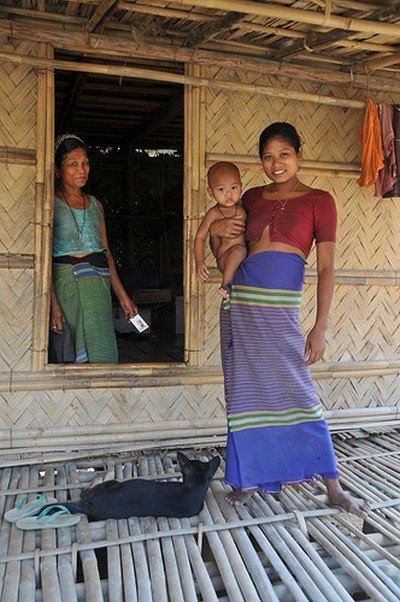This post is part of our special coverage Indigenous Rights.
Although outnumbered by the Bengali population, the close to one million indigenous and aboriginal population of Bangladesh live mainly in the Chittagong Hill Tracts. Over the years they have become vulnerable minorities.
During the 1970s and 80s, the government took steps to resettle Bengali homeless people in the three hilly districts of Bangladesh. There were resistances and insurgency by the local indigenous people and these previously tourist places became a protected militarized zone.
For decades Bengali settlers and soldiers have been accused of human rights violations against the tribal minorities while members of the Shanti Bahini and other rebel indigenous groups have committed similar violations, including the massacre of unarmed Bengali settlers. The 1997 Peace Treaty with Shanti Bahini granted a limited level of autonomy and stemmed the violence but the problem was not solved.
Recently ethnic violences sparked again and news media reported that four Bengali settlers were killed and 50 others were injured in Ramgarh on Sunday April 17, 2011. According to a statement by Amnesty International:
The latest round of tensions began on 14 April when a group of Bengali settlers occupied and tried to plant crops on areas within the Jumma’s ancestral lands, in Khagrachari District in south-eastern Bangladesh. After three Bengali settlers were killed on 17 April, allegedly by Jumma people, settlers looted surrounding indigenous villages and injured people, burning at least 60 homes.
Indigenous sources say they informed the local authorities – including the army, which has a heavy presence in the area – of the settlers’ movements, but they failed to act on the information.
The voices of the indigenous people are rarely heard in the mainstream media but through the Internet – blogs and Facebook – they have found a platform from which to be heard. In the Facebook group CHT Voice people have been wondering why only the casualties of Bengali settlers are being reported. Radhamon wrote:
News are being filtered, and media is BIASED. They DONT LIE, but they DONT TELL THE TRUTH.
A new blog called CHT News Update has this question:
Bangladeshi mainstream media has been overflown with biased news about Ramgarh incident. The journalists try to retain objectivity in their news. However, all news articles are being filtered by the security forces before they get published and thus the public is not made aware of the real story. If you look at the the Bangladeshi dailies, you will see news and pictures of injured and dead Bengali settlers. How come they never dare to publish the pictures of these injured Indigenous people?
Blogger and journalist Biplob Rahman writes at the Indigenous Bangla Blog [bn]:
Those who have tried to gather news on their own initiative, have learnt that although the majority of casualties are Bengalis but they were the first attackers. The indigenous people have tried to resist with their scanty resources. Not only that, the cause of the violence, the land dispute, was generated as the Bengali settlers tried to grab the lands of the indigenous Marmas living there.
Unheard Voice blog posts a round up of mainstream media news and also some news, images and video obtained via email.
Another blog CHTBD.Net is reporting that the number of houses of locals burnt are 95, and 4 indigenous persons are confirmed missing. In an interview Polen Chakma describes how he escaped death on April 17.
Anandi Kalyan quotes one of her friend's Facebook messages to describe [bn] how these incidents are accumulating hatred against Bengalis amongst the indigenous people:
There are unrests in the hills for decades. Let alone the statistics quoted in the media, I know from personal connections that my indigenous friends are victims one way or another. When I went to visit places like Bandarban, Rangamati, Teknaf and Cox's Bazar I saw that many businesses and settlements are owned by Bengalis. Those who are aboriginal there are cornered now. The hills have become agitated yet again and we are reading reports on attacks against Bengali settlers. The repressions against the indigenous people are being blacked out.
When I speak with my aboriginal friends hatred are forming inside them because of our land grabbing mentality. My friend, who remained apolitical over the years now also think of armed resistance.
We should not only think about the Chittagong Hill Tracts as an ‘awesome’ touristic place. To what extent we think about the well beings of the indigenous people living there?

An indigenous family in the Chittagong Hill Tracts. Image by Flickr by Jonas in China (CC BY-NC-SA 2.0).
Blogger and Journalist Arif Jebtik writes [bn]:
There comes a time when civil societies have to stand on their feet and boldly say the truth. The situation on the hills is demanding the same from us. The hills are for the people of the hills, you cannot hide the truth trying to impose logics of political science. The politicians have resettled homeless Bengalis in those hills. They had to build settlements for them and had to deploy army for their security. The problem starts here. We at the same time have endangered homeless Bengalis, our security forces and of course the indigenous people.
The only way to solve all problems persisting in the hills is to remove all the Bengali settlers.
This post is part of our special coverage Indigenous Rights.








6 comments